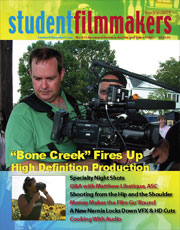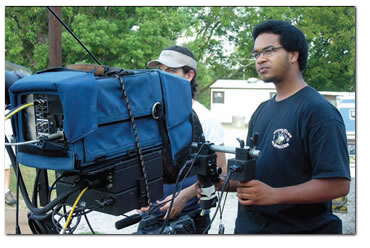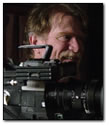Check out this article in the print edition of StudentFilmmakers Magazine, January 2008. More production stills featured in the print edition. Click here to get a copy and to subscribe >>
 Feature "Bone Creek" Fires Up High Def Production Feature "Bone Creek" Fires Up High Def Production
Challenge: New Format, New Workflow, and Achieving the 'Film Look'
by Michael Corbett
The details varied with each of the three cameras we used, but here is the basic menu selection for the film look:
(1) Recording format 720p. This results in better image quality than 1080i.
(2) Use 24p mode. Progressive scanning at 24 frames per second directly mimics the way a film camera captures images.
(3) Use a 1/50th of a second shutter speed (1/48th of a second on some cameras like the JVC). Video cameras default to a 1/60th of a second shutter speed which is approximately 17% faster than the film standard of 1/50th of a second. This does not seem like very much of a difference, but the slight additional blur of each frame at 1/50th of a second adds significantly to the film look.
(4) Select “Cine” or film gamma settings. This configures the camera to mimic the same color sensitivity curve as film.
Student J. Harris gets some hands-on practice operating the Jimmy Jib crane on the Piedmont Community College (PCC) class project production of the feature film �Bone Creek.�

The number one thing you can do to mimic the theatrical feature film look is to keep the depth of field as small as possible. Of course, this makes focus much more critical. This is exactly the point. It comes down to the look you achieve when the subject is in sharp focus and the background and other elements in the frame are slightly out of focus. It is this ability to focus the audience’s attention on the important story elements that makes the most film-like impact.
Quite simply it comes down to the fact that the longest lens on video cameras using 1/3 inch video capture chips is in the 40mm to 50mm range. With a 16mm film camera, you would shoot the same shot to get the same framing using a 100mm lens. With 35mm film, you would use a 200mm lens to get the same field size. Add to that most DP’s shooting film will light to an exposure of ƒ 5.6 or less to reduce the depth of field even further.
Until we are all using HD cameras with chips the size of a 35mm film frame like the Red camera and film camera lenses our only option to approximate this shallow depth of field look is to back the camera up as far as possible and use the longest lens setting on the camera. Use a high quality polarizing filter both indoors and outside, light to an ƒ 2 or ƒ 2.8 indoors and use the ND filters built into the camera when outside in daylight to keep the exposure to an ƒ 5.6 or less.
Flip also emphasized how important having a high quality monitor is for critical focus and lighting. He urged using a tent-like setup to provide a dark area to view the monitor when shooting day exteriors.
All three of the cameras we used on this production suffered from poor quality viewing systems. They just can’t make video screens yet with pixels small enough to get the really sharp resolution needed for critical focus. The solution for this is a viewing system like film cameras use that allows the operator to see directly through the lens.
My students and I had a great time shooting this picture. HD is here to stay, and I have learned to love it.
This article may not be reprinted in print or internet publications without express permission of StudentFilmmakers.com. Photos may not be copied or reproduced.
Check out this article in the January 2008 print edition of StudentFilmmakers magazine, page 22. Click here to get a copy of the January 2008 Edition, so you can read and enjoy all of the excellent articles inside.
About the Author:
 Michael Corbett has worked on television commercials and feature films in roles as varied as grip-electric to producer-director. Corbett presently serves as the Director of the Piedmont Community College Film and Video Production Technology Program in Yanceyville, North Carolina. Michael Corbett has worked on television commercials and feature films in roles as varied as grip-electric to producer-director. Corbett presently serves as the Director of the Piedmont Community College Film and Video Production Technology Program in Yanceyville, North Carolina.
Resources:
About StudentFilmmakers Magazine and StudentFilmmakers.com >>
Join the Film and Digital Networking Community >>
Post Your Films, Videos, Reels, and Trailers >>
Discuss Motion Picture Techniques in the Online Industry Forums >>
Get the StudentFilmmakers.com E-Newsletter >>
StudentFilmmakers magazine would like to hear from you!
Click here to share your comments and feedback about the magazine, monthly editions, your favorite articles, and your favorite topics.
We always welcome and appreciate your Reader Comments. View them here, and send yours to the editorial team today!
|


 Michael Corbett has worked on television commercials and feature films in roles as varied as grip-electric to producer-director. Corbett presently serves as the Director of the Piedmont Community College Film and Video Production Technology Program in Yanceyville, North Carolina.
Michael Corbett has worked on television commercials and feature films in roles as varied as grip-electric to producer-director. Corbett presently serves as the Director of the Piedmont Community College Film and Video Production Technology Program in Yanceyville, North Carolina.